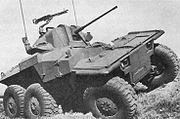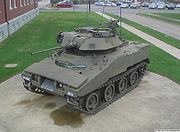
XM800 Armored Reconnaissance Scout Vehicle
Encyclopedia


Armoured personnel carrier
An armoured personnel carrier is an armoured fighting vehicle designed to transport infantry to the battlefield.APCs are usually armed with only a machine gun although variants carry recoilless rifles, anti-tank guided missiles , or mortars...
s, the M113
M113 armored personnel carrier
The M113 is a fully tracked armored personnel carrier that has formed the backbone of the United States Army's mechanized infantry units from the time of its first fielding in Vietnam in April 1962. The M113 was the most widely used armored vehicle of the U.S...
and M114, with vehicles with greatly improved fighting capabilities. While the MICV-65
MICV-65
MICV-65, short for Mechanized Infantry Combat Vehicle, 1965, was a US Army project that studied a number of armored fighting vehicles that would replace the M113 and M114 as well as take on a variety of new roles. A number of designs were studied as part of the MICV project, but none of the entered...
program focused on troop carriers, a separate requirement for a scout vehicle led to the XM800. None of the vehicles from the MICV-65 project entered production, although they provided valuable experience that was used in the M2 Bradley.
Two different vehicle designs were designed for the XM800 project, Lockheed
Lockheed Corporation
The Lockheed Corporation was an American aerospace company. Lockheed was founded in 1912 and later merged with Martin Marietta to form Lockheed Martin in 1995.-Origins:...
's XM800W 6 × 6 wheeled armored car and FMC
FMC Corp.
FMC Corporation is a chemical manufacturing company headquartered in Philadelphia, Pennsylvania. FMC employs over 4,800 people world wide, and had gross revenues of US$3.115 billion in 2008.-The Bean Spray Pump Company:...
's XM800T tracked version. Both models initially featured the same turret with the US-built version of the Hispano-Suiza HS.820
Hispano-Suiza HS.820
The Hispano-Suiza HS.820 was a 20 mm autocannon developed primarily for aircraft use, but more widely used in a series of ground-based anti-aircraft guns...
20 mm autocannon
Autocannon
An autocannon or automatic cannon is a rapid-fire projectile weapon firing a shell as opposed to the bullet fired by a machine gun. Autocannons often have a larger caliber than a machine gun . Usually, autocannons are smaller than a field gun or other artillery, and are mechanically loaded for a...
, the M139, as the primary weapon, as well as a M60
M60 machine gun
The M60 is a family of American general-purpose machine guns firing 7.62×51mm NATO cartridges from a disintegrating belt of M13 links...
-derived machine gun on a pintle mount. The M139 had been selected for all of the MICV projects. The XM800W was later equipped with a new turret design that kept the M139 cannon, but that had an upper cover that flipped forward to form a gun shield, or rearward to close up.

